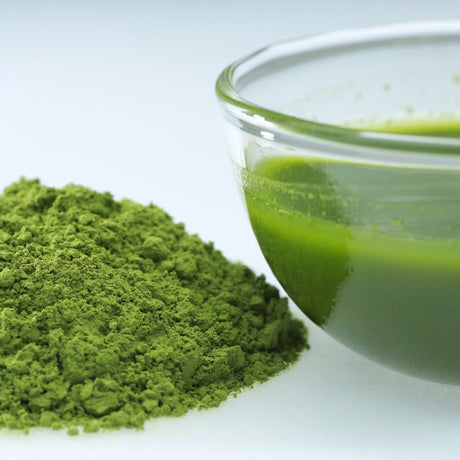
長田製茶の単一品種抹茶セット
ブレンドされていない単一の品種を味わうことは、抹茶(そしてお茶)に関する知識を深める素晴らしい方法ですが、同じ生産者が意図的にシリーズ化している場合にのみ有効です。風味と品質は、栽培技術(遮光、施肥など)、収穫時期と方法、加工、精製、粉砕技術など、多くの要因によって左右されます。これらの要因を意図的に調整しなければ、品種を有意義に比較することはできません。幸いなことに、茶匠の長田夏美氏は、静岡産の5種類の抹茶をブレンドしました。

ブレンドされていない単一の品種を味わうことは、抹茶(そしてお茶)に関する知識を深める素晴らしい方法ですが、同じ生産者が意図的にシリーズ化している場合にのみ有効です。風味と品質は、栽培技術(遮光、施肥など)、収穫時期と方法、加工、精製、粉砕技術など、多くの要因によって左右されます。これらの要因を意図的に調整しなければ、品種を有意義に比較することはできません。幸いなことに、茶匠の長田夏美氏は、静岡産の5種類の抹茶をブレンドしました。

今日のYunomi茶農家インタビューは、鹿児島県曽於市にある末吉茶房の3代目であり代表の又木建文さんです。又木さんは、お茶はただ喉の渇きを癒す飲み物ではなく、心を解きほぐし、人と人との繋がりを深めるものであるという考えを強く持っています。末吉茶房の茶農家の皆さんは、この理念のもと、丹精込めて丁寧に育てたお茶を、より多くの人に届けたいと考えています。そして、お茶だけでなく、暮らしに寄り添う、豊かな暮らしを提案していきたいと考えています。 2020年にYunomiで紹介記事を執筆させていただく機会をいただき、偶然にも又木さんのお茶に出会いました。それ以来、繊細で美味しいかぶせ茶を愛飲させていただいています。そして、インタビューでは又木さんからは一切触れられなかった、数々の高い評価を得ているお茶。初めてお会いしてから少し時間が経ちましたが、2023年2月上旬にようやく又木さんにインタビューすることができました。「お茶を飲むと心がほぐれる」とおっしゃっていた通り、お話をさせていただいた方の優しさと寛大さに感動し、リラックスしてお話することができました。これから、また木さんと末吉茶房について、そして末吉茶房の魅力をもっと知っていただけたら嬉しいです。 Moé:まずは、茶農家になるまでの道のりについてお伺いしたいと思います。あなたとご家族はどのようにしてお茶の世界に入ったのですか? 又木さん:私の家では、祖父がお茶作りを始めたのがきっかけです。祖父の知り合いが曽於市でお茶を作っていたのですが、その人がお茶作りをやめようとしていたんです。ところが祖父が「自分が継ごう」と言い出し、その家の茶畑を買ったのが、我が家のお茶作りの始まりでした。その後、2代目の父が茶畑を拡張し、より良いお茶を、より多くのお茶を作れるようにと製茶工場の機械も新しくしました。こうして祖父の代からお茶作りは続いていますが、私が正式に茶農家になったのは比較的最近のことで、2017年です。父と共にお茶作りをしてきました。もうすぐお茶作りを始めてから6年目になります。私自身、幼い頃から父がお茶を作る姿を見て、自分も茶農家になりたいと思っていました。ただ、いつから始めたいのかははっきりとは決めていませんでした。お茶や農業以外の世界を見てみたいという思いが、まずはありました。私は会計士としてキャリアをスタートしました。公認会計士(CPA)の資格も持っています。しかし、30歳になった頃、人生と将来について改めて考える時期になりました。その時、父が「お茶作りは年に一度だけだ」と言っていたのを思い出しました。そして、人は一生のうちに100杯もお茶を作ることはできない、と思いました。そして30歳になった時、まさにその時が来たと感じました。蘇州市に戻り、茶園経営を始めたのです。それが私のスタートです。 萌え: 茶農家になるまでの経緯をどのようにお考えですか?自然な流れだったのでしょうか? 又木さん:そうですね、気持ち的にはごく自然な流れだったと思います。幼い頃から茶農家になるという夢を持っていたので。ですから、会計士から茶農家への移行はスムーズでした。ただ、体力面での苦労はありました。長時間のデスクワーク(つまり、座りっぱなしの生活)から茶畑で働くようになったのです。肉体労働に慣れるのには、明らかに時間がかかりました!また、経済面でも、会計士はどんな仕事でも、決まった時間に定額の給料をもらえます(つまり、典型的なサラリーマンです)。茶農家はそうではありません。経済的な負担や生活の違いを痛感しました。 萌え: 最近、若い世代は急須でお茶を飲まない、いわゆる「ペットボトル世代」だと言われることがよくあります。茶農家のご家庭でいらっしゃるあなたにとって、この現象はご家族に、あるいは茶農家コミュニティ全体にどのような影響を与えていますか?あるいは、与えていませんか?経済的な面でも、その他の面でも。 マタキさん:つまり、今はほとんどの人がペットボトルでお茶を飲むので、お茶農家は今困っているのかとお尋ねですか? もえ:はい、以上です。長々と質問してしまい、申し訳ありません! 又木さん:ええ、本当にその通りです。末吉茶業でもそれを実感しています。祖父の時代から比べると、状況は厳しくなってきています。周りを見渡すと、多くの茶農家さんが辞めていくのを目にします。私が茶農家を6年間続けてきた中で、本当に美味しいお茶を作っていた農家さんが、経済的、資金的な理由でお茶を辞めていくのを見てきました。彼らも本当に美味しいお茶を作っていた農家さんだったとお伝えします。それでも、彼らがお茶作りをやめてしまうのは、人々が急須でお茶を飲まなくなったという厳しい現実が影響していると思います。 萌え: あなたの故郷である曽於市についてもう少し詳しくお伺いしたいのですが、私自身は鹿児島県に詳しいわけではありません。もちろん、鹿児島が日本有数の茶産地であることは知っていますが。曽於市にはたくさんの茶農家がいるとお考えですか? 又木さん:実はこの地域には昔からお茶農家があまり多くないんです。そもそも曽於市は規模が小さいんです。でも、鹿児島県全体のお茶の生産量の中で、曽於市のお茶が一番遅いというのも理由の一つなんです。曽於市のお茶のシーズンは遅いんです。南部に位置しているにもかかわらず、曽於市は平均気温が低いので、静岡県よりも遅いこともあるんですよ!とはいえ、お茶の収穫時期は遅いんです。これは日本の文化の一つなんですが、人々は「一番茶」をとても大切にしています。一番茶、一番茶。縁起が良いとされているんです。だから、一番茶は高値で取引されることが多いんです。曽於市のように収穫時期が遅いと、一番茶を欲しがっていた人たちが、もうお茶を買い終えてしまっていることが多いんです。そういう意味では、曽於市の茶農家が鹿児島県内の他の茶産地と競争するのは難しく、この地域に茶生産者が少ない理由の一つとなっています。 萌え: なるほど…でも、このような厳しい状況でもお茶作りを続けていらっしゃるんですね。本当に尊敬します! 又木さん:ありがとうございます。実は、曽於市とその周辺の渓谷を含む地域があるんです。江戸時代にはここでお茶が作られ、江戸幕府に送られていたという記録が残っています。ここは都城盆地と呼ばれていて、お茶の歴史が深く刻まれている地域です。ですから、お茶の栽培に非常に適した地域だと思っています。 萌え: なるほど…曽於市で、末吉さんのお茶を待つ価値があるんですね!?ところで、お話に関連してなんですが、末吉茶房の強みや特徴って何だと思いますか? 又木さん:はい。私たちのいる曽於市はお茶の栽培に適した環境です。気候も京都によく似ていると言われています。 萌え:あ、京都? 又木さん:はい、京都です。宇治みたいに… もえ:実は今京都にいるのでびっくりしました(笑)。 又木さん:(笑)なるほど。そうですね。京都は朝晩がとても冷え込むことで知られています。でも、日中は気温が上がります。だから霧が発生しやすいんです。霧は良いお茶を育てるのに貴重な条件なんです。曽於市を含む都城盆地は京都と気候が似ていると言われています。曽於市はお茶の栽培に適した土壌を持っているので、お茶作りがここで始まったんです。もう一つの強みは、京都の茶農家さんがどうやってやっているのかよく分かりませんが、末吉茶業では、お茶の栽培から収穫、もちろん荒茶作り、そして加工、仕上げまで全て自分たちで行っています。これは近年では珍しいことだと思います。例えば関東では、多くの茶農家さんがお茶の加工に製茶工場を利用していると思います。 萌:なるほど。 和束(京都府の有名な茶産地)でも、農家さんがお茶を摘んで、その茶葉を袋ごと共同加工場に持ち込んでいる様子を見かけました。最近はそういう共同加工場が増えているそうですね。では、末吉茶工房では、お茶の栽培から加工まで、すべて自分たちで行っているんですね? 又木さん:そうです。祖父の代からずっと、自社工場で茶葉の加工をしています。そして何より、お客様の声を常に大切にしてきました。お客様の声こそが何よりも大切です。それが私たちの強みだと信じています。 末吉茶房のキッチンカー Moé:私も普段から日本茶を愛飲しているので、お茶を飲んでくれる人のことを本当に大切にされていると感じています。そうそう、そういえば、ウェブサイトやSNSでキッチンカーの写真を見ていて気になったんです。キッチンカーの存在について、もう少し詳しく教えていただけますか?どのように使われているんですか?...

日本人の間で昔から愛され、人気が衰えないお茶の一つがほうじ茶です。京都発祥の緑茶で、焙じたお茶です(その歴史については別の記事で触れます!)。 煎茶とは対照的に、ほうじ茶はカフェイン含有量が少ないため、子供からお年寄りまで、そして夕方から夜にかけても好んで飲まれています。 最近、同じ植物( カメリウス・セニシス)から作られているのに、なぜほうじ茶はカフェインが少ないのかと聞かれました。正直なところ、ほうじ茶を日常的に飲んで育った私にとって、この疑問は頭に浮かびませんでした。しかし、最初に考えたのは、ほうじ茶の焙煎工程が、他の日本茶(例えば煎茶)の蒸し製法とは異なるためではないかということでした。さらに調べてみると、ほうじ茶のカフェイン含有量が少ないのは、主に3つの要因によるものであることがわかりました。 まず、茶葉を高温で焙煎するという工程については、私の考えは正しかったです。具体的には、ほうじ茶を作る際、茶葉は160~220℃(焙煎の濃さによって異なります)で焙煎されます。これは通常、カフェインの昇華沸点である178℃を超えることを意味します。つまり、カフェインは蒸発し、茶葉に含まれるカフェイン含有量が減少します。この焙煎技術によって、ほうじ茶は赤褐色になり、甘く土っぽい香りが生まれます。ただし、焙煎方法(例えば、炭火焙煎ではなく、回転する金属樽を加熱するガス火など)、焙煎時間と火力(その日の気温や湿度にも影響されます)、そして使用する茶葉などによって、風味は大きく異なることに注意してください。 下:徳島県有瀬村を拠点とするアメリカ人茶農家ヤンシーさんが、炭火でほうじ茶を淹れています。 浅煎りのほうじ茶は、繊細な味わいでありながら、穏やかで落ち着いた夜にぴったりです。 この投稿をInstagramで見る やんちゃ×ぼろ屋(@yancha_boroya)がシェアした投稿 ほうじ茶のカフェイン含有量に影響を与える2つ目の要因、つまり、ほうじ茶を作るのに使われる茶葉の種類について考えてみましょう。煎茶、玉露、ほうじ茶はすべて同じ茶樹から作られますが、ほうじ茶は、夏や秋に収穫された二番茶や三番茶など、比較的遅い時期に収穫された、大きく成熟した葉から作られることが多いです。一般的に、煎茶や玉露のような一番茶を作るには、早い時期に収穫された一番茶(例えば、春に収穫された一番茶)が使われます。時間をかけて成熟し、成長した遅い時期に収穫された葉は、カフェイン含有量が低くなります。 最後に、ほうじ茶には茎や小枝が含まれることが多く、これらにはカフェインが非常に少なく含まれているため、最終製品のカフェイン含有量が薄められてしまいます。 2 種類のほうじ茶を並べた画像:左: 喜六茶園の在来晩春収穫ほうじ茶。 ザイライは特定の品種ではありませんが、現在日本では非常に珍しい品種です。右:善香園の茎ほうじ茶。番茶の最終収穫時の茎・茎のみを使用して特別に作られています。 くき茶ほうじ茶はカフェインが一番少ない! 並べて比較した画像からもわかるように、ほうじ茶は茶葉の種類や部位、刻み方、ふるい分け方、焙煎方法など、様々な要素によって見た目が全く異なります。Yunomi で提供される豊富なほうじ茶コレクションを見れば、その見た目の違いはさらに明らかになります。 まとめると、ほうじ茶にカフェインが少ない理由は3つあります。 焙煎工程 収穫期 茎と小枝(葉以外の部分) さらに、私のように実際の数値やデータをご覧になりたい方は、こちらをご覧ください!標準的な量のほうじ茶1杯(250ml)には、約7.7mgのカフェインが含まれています。ほうじ茶のカフェイン含有量は、コーヒー、抹茶、煎茶よりも低いため、カフェインに敏感な方や、特に一日の後半にカフェイン摂取量を減らしたい方にとって、良い代替品となります。 以下に、様々な種類の日本茶のカフェイン含有量を具体的に調べた日本の研究データを示します(1)。これは1つの研究に基づいたデータであり、集計データではないことにご注意ください。また、どの研究にも限界があることにご注意ください。それでも、この研究データを用いて、様々な日本茶のカフェイン含有量の相対的な傾向を視覚的に把握していただけるよう、図解で示しました。 注:これらは一般的な数値であり、カフェイン含有量はこの記事で触れられているいくつかの要因によって異なります。 ほうじ茶はカフェインが全く含まれていないわけではありませんが、午後や夜に飲んでも睡眠を妨げることなく飲める程度にはカフェイン含有量は低いです(カフェインに極度に敏感な方を除いて)。しかし、先ほども述べたように、ほうじ茶の風味や香りは、様々な要因によって大きく異なります。とはいえ、もしほうじ茶がお好きなら、ぜひ色々な種類のほうじ茶を試してみてください!私も、自分のお茶のレパートリーに加えたい、風味豊かなほうじ茶を常に発見しています。午後や夜を明るくしてくれる、ささやかながらも意義深い喜び。きっと私の「喜びの本(2)」に載るでしょう。乾杯! 参考文献: 後藤 剛・長島 秀・吉田...

日本国内だけでなく、世界中でお茶の賞(そしてより一般的な食品の賞)が数多く開催されていますが、Yunomi.lifeで「お茶のコンクール」と呼ぶ場合、それは日本各地で開催される茶農家(ただし、応募作品が自社の茶畑であれば、「農家」には農家協同組合や工場も含まれます)のみが参加できる茶のコンクールを指します。これらのコンクールは市、都道府県、または複数の都道府県からなる地域で開催される場合があり、全国レベルのコンクールも1つあります。大規模なコンクールへの応募には、小規模で地域的なコンクールからの推薦が必要となる場合が多くあります。 この投稿をInstagramで見る 2019年 関東茶品評会オークションby 鷹ノ羽森田園 takanoha_moritaen (@takanoha_moritaen) - MORITA TEA GARDEN 以下のカテゴリーの茶葉は10kg単位で(一部の茶葉は4kg単位でも)提出できます。提出バッチは、たとえ生産バッチが10kg以上の場合であっても、その特定のバッチのみとみなされます。農家は、1回または複数のコンテストのために、そのバッチを栽培・収穫し、乾燥葉への加工や完成茶葉への精製を外部の業者に依頼することもあります。農家がこれらのバッチを丁寧に作り上げるため、私は「コンテストグレード」の茶葉と呼んでいます。 コンテストは農林水産省が主催し、応募作品数が一定数に達した場合(または200点満点に達した場合)、各部門の最高賞は大臣賞となります(注:この基準は確認が必要です)。さらに、その他の賞も授与され、応募作品は1等(世界の類似コンテストに合わせて金メダル賞と訳しています)、2等(銀メダル)、3等(銅メダル)に分類されます。これらの中で、順位は「席」によって分類されます。つまり、1等7席は基本的に7位、2等3席は銀メダルレベルで3位ですが、全体の順位は金メダル受賞者の数によって異なります。 これらのコンテストに出品されたロットは、入札権を持つ承認された卸売業者にオークションで売却されます。これはサイレントオークションであり、入札者はランキングを知ることができますが、有名な農家であれば、ランキングやポイントスコアが低くても、より高い入札額を獲得できる可能性があります。ただし、最高得点の農家よりも高い入札額を獲得することは稀です。 出典: http://shizuoka-cha.com/69ocha-fes/gaiyou/pdf/69_zenkoku_cha_hinpyokai_kaisai_youryo.pdf お茶の種類 内部 外部の 抽出時間 香り 液体の色 味(文字通り「栄養」) 淹れた葉の色 外観 合計ポイント 通常の煎茶 5分 75 30...

このブログ投稿はゲストによって書かれました ジミー・バーリッジ、植物科学博士 そして、お茶の栽培学、化学、テロワールの交わる領域に関心が高まっているお茶愛好家です(科学的な部分がわかりにくいのは彼のせいです!)。 お茶の種類によって、風味は大きく異なります。例えば、煎茶は紅茶では決して味わえない甘さと舌触りのとろみがあります。萎凋した緑茶は、爽やかさと刺激を兼ね備えた、シンプルさと透明感を備えています。紅茶に一般的に用いられる茶品種は、酸化によって香りが増しますが、インドやアフリカの茶とは全く異なる品種から作られる日本の紅茶は、より繊細で、花のような香りが強い傾向があります。釜炒り茶と玉緑茶は、煎茶とは異なる製法で作られる緑茶で、それぞれ異なる味わいと香りの広がりを楽しめます。 上:神奈川県足柄市小倉茶園の一番茶(和紅茶)と、湯呑茶道場の春煎茶5種類を比較。下: 梶原茶園の5種類の紅茶を試飲。 植物化学物質と風味 植物化学物質は太古の昔から人間の生活に深く関わってきました。これらの植物化学物質の多くは、アスピリンなどの伝統医薬品や現代医薬品の原料となっています。この一般的な鎮痛剤の有効成分はアセチルサリチル酸で、その形態は古代エジプト人によってヤナギの樹皮から初めて抽出されました(Desborough and Keeling, 2017)。 その他の植物化学物質は、柑橘類に含まれるクエン酸のように、食品の風味の基本的な側面です。トマトには約400種類の揮発性化学物質が確認されており、そのうち約12種類が特に重要です。そしてもちろん、トマトに特徴的な色を与えるカロテノイドの一種であるリコピンもあります(Petro‐Turza, 1986; Cheng et al., 2020; Tomatosphere, 2022)。特にニンジンに多く含まれるカロテノイドは、クロロフィルの補助色素です。カロテノイドとクロロフィルはどちらも、お茶の香りと味の非常に重要な成分です。カロテノイドから他の化学物質への変換は、酸化の主要な機能の一つであり、紅茶を区別するのに役立ちます。 生育条件、日陰、害虫被害、施肥、標高、気温変動、土壌の種類、加工、熟成など、すべてが植物化学物質のプロファイル、ひいては味やお茶の味わいに影響を与えます(Ahmed et al., 2013; Zhang et al., 2020; 気候変動に関する以前の記事を参照)。お茶には数千種類の化合物が含まれており、製茶工程を通じて変化する可能性があります。完成したお茶を最終的に抽出すると、揮発性の高い植物化学物質の一部が香りとして放出され、揮発性のない植物化学物質は茶葉に含まれます。 お茶に含まれる3つの重要な植物化学物質の化学構造。L-テアニンはお茶のうま味成分であるアミノ酸です。苦味のあるカフェインはメチルキサンチン系の刺激物質で、脳内の特定の受容体を遮断することで神経伝達物質の産生を促進します。ダムセノンは紅茶に含まれる多くの芳香物質の一つで、カロテノイドの変換によって生成されます。ローズケトン系に属し、様々なアイソフォームが存在し、フルーティーからフローラル、ウッディまで幅広い風味を生み出します。バーボンにも含まれています。 茶葉の化学組成を変える 農家や茶愛好家は、栽培条件や収穫時期によってお茶の風味が異なることを何世紀にもわたって知っていました。この関連性に最初に気づいたのは、おそらく宇治地方の農家でしょう。彼らは茶葉に陰影をつけることで、よりうま味のあるお茶ができることを知りました(...

植物は頂芽、つまり枝の先端から生える新しい葉を優先しますが、茎の下の方にある葉の基部から生える側芽、つまり新しい葉も生成します。 手摘みが必要な高品質の葉では、頂点の芽が摘み取られ、植物は側芽に栄養を送るようになり、側芽がより均等に成長して、植物が同様に高品質の葉をより多く生産できるようになります。

岡山県といえば、どんなお茶を思い浮かべますか? 美作番茶と答えた方、まさにその通りです!大阪の西に位置する岡山県は、晴天の日が多く果物の産地( 備前焼でも有名)としてよく知られていますが、夏に作られる伝統的な番茶があります。具体的には、梅雨が明けてお盆が始まる7月中旬頃です。そう、一年で最も暑い時期です。美作番茶の特徴の一つは、その艶やかな琥珀色です。他の多くの地域の番茶と同様に、美作番茶の製造工程は非常に特殊です。 美作番茶の製造方法 茶葉は7月中旬から8月中旬にかけて茎とともに収穫されます。 収穫した葉と茎は、大きな鉄鍋で約40分から1時間煮込まれます。その間、葉は何度もひっくり返されます。 煮出した茶葉は藁の上に広げられます(天日干し)。現在では、青黒のビニールシートの上で天日干しされることが多くなっています。 茶葉が乾いたら、お茶を煮たときの煮汁をお茶に注ぎます。 このプロセスは2〜3回繰り返されます。 最後の仕上げは、再び天日干しで完全に乾燥させることです。このお茶を作るのに、大変な手間がかかることは想像に難くありません。 この伝統的な番茶は、室町時代(1333-1573)に誕生し、日本の歴史上有名な剣豪であり哲学者である宮本武蔵の好物だったと言われています。興味深いことに、室町時代の文献の一つには、三大茶として狭山の武蔵、京都の山城、岡山の美作が挙げられていたと言われています。岡山県での茶栽培は、もともと美作市の南にある間木山の寺院で僧侶が茶を飲んでいたことから始まったとされています。そして、その後、この地域に茶栽培が広まりました。そのため、岡山県は主要なお茶の産地として最初に思い浮かぶ県ではないかもしれませんが、美作地域は番茶でよく知られています。 ほうじ茶がお好きな方なら、美作番茶はきっと気に入っていただけるでしょう。淹れたての茶葉は、茎ごと琥珀色に輝き、艶やかな艶やかな外観をしています。夏の太陽のエネルギーと熱から生まれた、深く豊かな風味を持つ、控えめながらも優しく美味しいお茶です。一般的に番茶はさっぱりとした味わいが主流ですが、美作番茶は独自の製法で、甘く丸みのあるまろやかな味わいに仕上がっています。暑い夏の疲れを癒すため、あるいは自分に優しくするために、ぜひ飲みたいお茶です。秋分の日も過ぎ、温かい飲み物が美味しい季節になりました。最近の私にとって、この番茶は元気の源となっています。柿や栗、 チーズといった秋の味覚と合わせて、この美味しい番茶を味わうのが楽しみです。 風龍の美作番茶とマルシェの柿を温かい一杯。 日本の地域特有の番茶に関するさらに詳しい情報: 日本の伝統的な民芸茶を守る「茶園みとちゃ」の茶農家、栢下悠樹さんへのインタビュー 日本茶発見:三年番茶 冬に収穫される希少な日本茶「寒茶」 地域限定の擬音語茶 美作番茶の製造工程の写真は、 小倉茶園より提供されました。小田原を拠点とする小倉さんが、岡山県美作市でこの番茶の製造に携わった時のものです。

自宅で淹れた日本茶をきちんと淹れたのに、商品説明や口コミでの評価と味が違った、そんな経験はありませんか? この記事が、もしかしたらあなたの疑問を解決してくれるかもしれません。皆さんはそのような経験はしていないかもしれませんが、この夏私が経験した面白い体験をシェアしたいと思います。 ヨーロッパ旅行中に衝撃を受けたこと 今年の夏、イギリスでの休暇に、お気に入りの日本緑茶を持っていきました。 ある日、その茶葉でお茶を淹れてみたら、その味に衝撃を受けました。日本のお茶とは全く違う味でした。渋みが少なく、後味が少し変でした。「家と同じように淹れたのに、どうしてこんな味になるんだろう?」 ふと、初めて水道水を飲んだ日のことを思い出しました。水の味は、私が住んでいた日本の水道水とは全く違いました。まるで、私が日本で時々作って飲んでいる「にがり」入りの水のようでした。 「にがり」とは、海水から塩分を沈殿させた後に残る液体で、マグネシウム、カリウム、カルシウムなどのミネラルを豊富に含んでいます。 にがりの詳細については、こちらをご覧ください。 そこの水にはきっとミネラルがたくさん含まれていたのでしょう。つまり、水の硬度がかなり高かったのでしょう。だから、水の硬度がお茶の味に影響するのだと思いました。 水の硬度とは 水の硬度の簡単な定義は、水中に溶解しているカルシウムとマグネシウムの量です。WHO(世界保健機関)による水質分類の一般的なガイドライン カルシウムとマグネシウムが 0 ~ 60 mg/L (ミリグラム/リットル) の場合は軟水、61 ~ 120 mg/L の場合は中硬水、121 ~ 180 mg/L の場合は硬水、180 mg/L を超える場合は非常に硬水と分類されます。 日本の水道水は主に河川水から得られているため、日本の水の硬度は他の国よりも低いです。一方、ヨーロッパ諸国の水道水は地下水から得られており、日本の川は他の国よりも急勾配で短いため、河川水は急速に流れ落ちる傾向があります。 私が住んでいる関東地方、神奈川県小田原市の水道水の硬度を見てみましょう。硬度は51mg/Lで、軟水に分類されます。日本の水道水の硬度は20~80mg/Lの範囲にある地域が多く、平均は48.9mg/Lです。関東地方は北海道や東北地方に比べて硬度が高い傾向にあります。 私が滞在したイギリスの地域の水の硬度はどうだったでしょうか?201mg以上あり、明らかに硬水です。 英国は硬水地域である傾向がありますが、北部は主に軟水地域です。ヨーロッパは硬水地域とされていますが、一部に軟水地域も存在します。...

今日は、抹茶を点てる際に欠かせない、茶筅(ちゃせん)について、特に茶筅作りに使われる竹についてお話したいと思います。茶筅は私たちにとって当たり前のものかもしれませんが、抹茶の粉を均一に混ぜ合わせ、クリーミーな泡を作る茶筅の力は実に素晴らしいものです。しかも、茶筅はたった一本の竹から作られ、その竹は60~120本の繊細な竹筋に分かれているというから驚きです。 茶筅作りの歴史 茶筅の起源と歴史について簡単に触れると、中国の宋代には、粉茶を泡立てる「點茶」を点てる茶筅のようなものが使われており、それが後に日本に伝わったと言われています。しかし、この茶筅の外観や使用方法については不明瞭な点があります。日本の茶筅に関する最初の記録は 、室町時代中期(1336年 - 1573年) 、足利義政が8代将軍だった時代に遡ります。伝説によると、茶人の村田珠光が親友で高山城主の次男である入戸宗水に最高級の茶筅を求めたのが、日本の茶筅作りの始まりと言われています。 村田珠光は高山称名寺の僧侶でした。茶人であっただけでなく、詩歌(連歌や和歌の名手)、書道でも名を馳せ、侘び茶の創始者、茶道に大きな影響を与えた人物として広く知られています。この茶筅は村田珠光が京都に移り住んだ後富美院天皇に入道宗水から献上されたものです。天皇はこの手造りの精緻な茶筅を大変お気に召し、「高峰」(後に高山茶筅と呼ばれる)と名付けたと伝えられています。宗水はこのお褒めの言葉に深く感銘を受け、以後茶筅作りに専念することとなり、茶筅は高山家の名物工芸品となりました。 それ以来、高山の茶筅職人たちは技を磨き、何世代にもわたってその熟練の技を伝えてきました。今日、茶筅職人の中には18代目、あるいは25代目もいます。残念ながら、日本の多くの貴重な職人技と同様に、茶筅作りの技術も衰退傾向にあります。実際、今日の抹茶筅のほとんどは日本国外で大量生産されています(大部分は中国製です)。しかし、最高品質のものは、500年以上もの間、奈良県高山の小さな村で地元産の竹から今も作られています。約18人の茶筅職人が今も残っており、家族の伝統を受け継いでいます。Yunomiニュースレターをご覧になっている方はご存知かもしれませんが、今年6月には25代目の職人である翠花園谷村安三郎氏をYunomiコレクションに迎えました。この伝統的な職人技が失われるのを防ぐため、これらの家では家族以外から弟子を取るようになってきています。 奈良県高山村翠華園の茶筅職人、谷村安ぶろう氏。 茶筅作りの根源、竹 まず、竹そのものについて少し触れておきます。竹はイネ科( Poaceae )に属する常緑多年生植物です。世界には約1,500種の竹があり、そのうち約600種が日本に生息しています。竹は温暖多湿の地域で急速に成長します。実際、日本の農村部では農家が伝統的に行ってきたような適切な管理が行われず、多くの種が急速に拡散し、現在では日本に生息する種の半分が侵略的外来種とみなされています。 竹は草なので、樹木のような形成層を持たず、同じ幹が季節ごとに太くなることはありません。一本の幹は5~10年しか生きられませんが、竹林全体は数十年、通常は花が咲くまで生き続けます。興味深いことに、竹林の竹は60~120年に一度、一斉に花を咲かせます。花が咲くと(これは非常に特殊な現象です) 、竹林全体が枯れてしまい、回復には約10年かかります。 毎シーズン、地下茎から新しい芽(稈)が出てきます。2年目以降は、稈の上向きの成長は緩やかになりますが、竹の内側(肉の部分)はより強く硬くなります。しかし、これには限界があり、7年ほどで脆くなるという説もあります。そのため、工芸品に使われる竹のほとんどは、3年から7年の間に作られます。茶筅に使われる竹は通常3年ものです。 竹の魅力的な特性 竹には独特の抗菌作用と消臭作用があることが知られています。日本では、乾燥したタケノコの皮はおにぎりを包むのに使われたり、精肉店では肉を包むのに使われたりしました。近年、竹の抗菌作用は科学界からも注目を集めており、竹エキスの抗菌作用を調査する研究も行われています。消臭作用に関しては、野生のクマが獲物から自分の匂いを隠すために竹の葉を食べていたと言われています。実際、竹を主食とするパンダの糞は無臭であることはよく知られています。また、竹は強くしなやかな性質も魅力的です。箸、まな板、スコップ、籠、ザルなど、様々な伝統的な家庭用品に竹が使われていることからもそれが分かります。これらの竹の優れた特性は、茶筅を作るのにも非常に適していることを反映しています。 茶筅作りに使われる竹の種類 日本には数百種の竹がありますが、茶筅用の竹には特別な条件が求められます。茶筅は通常、晩秋に3年生の竹を伐採し、2ヶ月間天日干しして作られます。この寒天乾燥は「寒干し」と呼ばれます。 寒干し。文字通り「冷たく乾燥させる」という意味です。茶筅作りの伝統産業である奈良県高山市では、500年もの間、寒干しは美しい冬の風物詩となっています。 奈良県高山村の翠花園では、雪景色が美しさを引き立て、竹を寒干ししている風景が広がっています。 日本茶を淹れるのに最適な環境があるように、山間部に位置する高山の穏やかな日差しと涼しい風は、竹を丈夫で艶やかな光沢に仕上げます。高山の茶筅職人たちは、化学薬品やカビを一切使わずに育てられた良質の竹を厳選。写真のように冬の間天日干しした後、さらに2年間蔵で乾燥させます。この間に折れたり曲がったりした竹は取り除かれるため、茶筅の原料となる竹は厳選されたものです。実は、茶筅職人が技術を習得する過程で、茶筅となる竹を見分けることが、最初に求められるスキルの一つなのです。 選別した竹を大きな鍋に入れて煮る工程は「油抜き」と呼ばれます。熱と水に浸した竹の重さのため、非常に手間のかかる工程です。この工程で竹は洗浄され、土などの自然由来の粒子が取り除かれます。また、竹に含まれる余分な油分も除去されるため、竹の耐久性が向上します。その後、冷間乾燥が行われます。 茶筅の最終的な見た目は、使用する竹の種類によって決まります。茶筅は通常、白竹(しらたけ)、煤竹(すすたけ)、黒竹(くろたけ)の3種類の竹から作られています。中には真竹(まんだけ)から作られるものもあります。以下の茶筅の画像では、形、色、歯の仕上げのカーブ、そして歯の中央の結び方に違いが見られます。 翠花園の茶筅の一部。使用されている竹の種類が表現されています。左から白竹、 薄竹、 黒竹/紫竹。 白竹は最も一般的で経済的な種類の竹で、小さめだが維管束が多いため、茶筅を作るのに適しています。表面は細かく密度が高いですが、折れやすいです。一方、黒竹は抹茶筅を作るための最も頑丈な材料です。密度が高いため、彫刻が非常に困難です。しかし、より耐久性があり、通常の白竹茶筅の3倍の寿命があります。煤竹は、何十年、時には何世紀も(100年から200年)調理用の火の煙で染まった竹であるため、ユニークで珍しい竹です。日本の伝統的な家屋では、これらの竹の茎は茅葺き屋根に使われていました。 これらの家の囲炉裏の上や近くの竹の茎は、徐々に独特の自然な茶色に染まり、これらの屋根が取り替えられたときに、竹は茶筅職人に売られ、高品質の茶筅や茶杓に加工されました。現在では大変希少で貴重なものと考えられています。伝統的な日本家屋の数が減少傾向にあるため、残念ながらこのタイプの家も時とともに姿を消す可能性があります。...

茶から海へ:森林、栄養動態、そして茶栽培ジミー・バーリッジ著 注目画像: 松本兼六茶園の茶草場栽培。茶畑の周囲の草を刈り、乾燥させ、株間に敷き詰めることで、茶畑の肥沃化と雑草の抑制を図っています。写真は、植えたばかりの幸春品種の茶畑です。 水蒸気は上昇し、山へと漂います。雨は山に降り注ぎ、土壌に染み込み、泉となって海へと流れ込みます。私たちの農業は土壌、水、そして水の流れにまで影響を与えます。山の茶も海の魚も、私たちに共に良い関係を築くよう呼びかけています。その結果、良質な茶と健全な生態系が生まれるのです。 導入 人間、森林、そして水の関係は、私たちが世界に影響を与える最も古く、長きにわたり、そして根本的な方法の一つです。本稿では、人々とその農業ニーズが、山から海に至るまで、土地や水路とどのように関わってきたかを概観し、特に茶葉に焦点を当てます。茶園における栄養動態に触れ、茶葉生産が下流の環境にどのような影響を与えるかを説明します。上流域の人々と下流域の人々の間の協力が、両者が依存する生態系の適切な機能をどのように確保しているかを示す事例を紹介します。 歴史的な森林管理 日本の農業の歴史は、地質、地形、そして統治者や人口集中地の支配によって特徴づけられています。最も顕著な例として、記念碑建造、都市建設、木炭製造、そして農民の燃料、建築資材、肥料、そしてもちろん食料生産のための緑化資材の需要によって、次々と樹木伐採が進められました。学者のコンラッド・トットマン氏は、日本の森林利用と管理の歴史について優れた研究を行っています。こちらに短い論文へのリンクがあります。森林史に関するセクションの資料の大部分は彼の研究に基づいています。参考文献をご覧ください。 日本で最も古く、壮大な樹木が最も有名で、おそらくは広範囲に利用されたのは、数多くの寺院、神社、城、そして大名や天皇の邸宅の建設でした。帝国が拡大するにつれ、ほぼ完全に木材で建設された都市も増加しました。家庭の調理中の火事や戦争による火災は、建物を頻繁に破壊し、時には都市の大部分を破壊したため、再建のためにさらに多くの木材が伐採されました。 東京・御岳山にある大きな古木。写真提供:岸田萌絵 森林管理は、現代の栄養管理の先駆けとも言えるもので、主に二つの目的で行われました。一つは林産物の安定供給を確保すること、もう一つは浸食、堆積、森林からの不均一な水供給によって引き起こされる洪水や干ばつなど、下流への悪影響を防ぐことです。水が堆積物を運ぶことで生じる堆積は、魚類や水生生物にとっての水質を即座に低下させるという悪影響を及ぼし、さらにこの堆積物が下流に堆積すると、水の流れや川の健全性にも悪影響を及ぼします。この堆積によって川は浅くなり、川幅も広くなるため、流れが遅くなり、さらなる堆積が促進されます。これは一種のフィードバックサイクルです。堆積は水田などの低地の畑を洪水の影響を受けやすくします。そのため、統治者は上流への堆積物の流出を減らすことで、これらの生産性の高い畑への被害を防ごうとしました。これに加えて、建設、石炭、その他さまざまな用途のために木を伐採し続けたいという願望により、日本では森林管理が推進され、保全、計画伐採、再生の考慮、再植林、そして人工林業といった実験が進められました。 主に1種類の樹木からなる、若い再植林地の写真2枚。左は愛知県、右は東京都青梅市。写真提供:岸田萌絵。 森林資源をより集約的かつ分散的に利用したのは農民であり、彼らは歴史の大部分において当然ながら人口の大多数を占めていました。農村の人々は調理や暖房用の燃料を集めるだけでなく、木炭を作るための木材も収集し、都市住民に販売していました。さらに、日本の伝統的な農業システムは、ブラシ、草、苔、落ち葉など、基本的に堆肥化可能なあらゆる有機物を収集し、農地の土壌に混ぜ込むことに依存しています。この有機物は分解され、栄養素がゆっくりと作物に利用できるようになります。伝統的な農法を美化しないためにも、多くの農民が有機物を燃やし、灰を土壌に混ぜていたことも言及しておかなければなりません。これにより栄養素ははるかに早く利用可能になりましたが、明らかにほぼすべての炭素が失われ、大気中の二酸化炭素濃度の上昇につながりました。 燃料や建築目的の大規模かつ集中的な樹木伐採は、都市、寺院、貴族の邸宅、そして農民による下草、苔、森林の残骸の採取に顕著に見られ、日本の森林構造、構成、そして生態系を決定づけ、変容させました。こうした森林構造の変化の影響を示す興味深い例の一つは、多様性に富み成熟した、完全に日陰のある森林を好むヒラタケ(ヒラタケ)が、13世紀頃にマツタケに取って代わられたことです。マツタケは撹乱された景観でも繁殖し、未植林の多様な森林に取って代わられた、マツが優占する森林植林地でもよく育ちます(Totman, 2000)。農業拡大、貴族階級の急速な成長、そしてマツタケの増殖というこの関連性は、マツタケが日本文化の構成要素となった理由を説明する一助となるかもしれません(人間とキノコの関係に興味がある方は、アン・ツィング著『世界の果てのキノコ、マツタケ』をご覧ください)。 混交林に咲く、繊細で儚いカタクリ(Erythronium japonicum、ヤマユリの一種)。写真提供:岸田萌。 茶は、気温の変化や朝霧といったテロワール(土壌)に付随する環境要因を活用するため、山の斜面で栽培されることが多いですが、米、大豆、ソバ、果物といった他の作物が、管理がはるかに容易な平坦な低地で栽培されているという実利的な理由もあります。茶は、個々の畝が小さな段々畑を占有できるため、急斜面でも栽培しやすいという利点があります。さらに、茶は多年生作物であり、耕起を必要とせず、年間を通じて土壌を覆っているため、耕起を必要とし、年間の一部の期間土壌を覆わない一年生作物ほど土壌浸食を助長しません。 京都府和束町にある急斜面の茶畑と単一樹林。写真はジミー・バーリッジ撮影。 茶の生産と施肥 近代になって合成窒素肥料が利用可能になる以前、茶農家は日本の他のほとんどの農家と同様に、前述のように森林を含む周辺地域から有機物を採取し、畑に施用していました。茶の場合、これはこのインタビューで言及されている「茶草場法」と呼ばれています。茶草場法、そしてより現代では加工されたコウモリの糞や魚粉を肥料として使用する方法は、自然に存在する土壌微生物も利用する栄養素を比較的ゆっくりと放出します。しかし、特に合成窒素肥料の導入以降、茶には大量の肥料が用いられることが多くなりました。施肥は、春の豊かな生育を促進し、複数回の収穫を可能にします。また、窒素が豊富でうま味に富んだ葉を育てるのにも役立ちます。 以前の投稿で述べたように、高品質のお茶のうま味は、窒素を豊富に含むアミノ酸の量と関連しています。 遮光は、植物がクロロフィル(葉緑素)の生成を促進するための古典的な方法です。クロロフィルは、太陽光を利用して二酸化炭素を糖に変換し、さらにうま味成分である窒素を豊富に含む化合物を生成するユニークな分子です。 合成窒素肥料は、大気中の窒素(互いに三重結合した2つの窒素原子)を分解し、次に窒素を水素と結合させてアンモニアを生成し、その後、植物が利用できる他の形態の窒素を生成することによって生成されます。このプロセスでは、反応に必要な高圧高温環境を作り出すために、大量の化石燃料由来のエネルギーが必要です。このプロセスは第一次世界大戦中に初めて開発されましたが、肥料の大規模生産に使用されたのは第二次世界大戦後です。日本では、多くの地域と同様に、この新しい窒素肥料源は、急速な人口増加と、森林や伝統的な栄養源の深刻な枯渇の時期に登場しました。そのため、伝統的な方法では急速に増加する人口の農業需要を満たすことができないと考える人が多く、実際、世界規模で合成肥料の普及により、何百万人もの人々に食料を供給することができました。日本では、戦後から1990年代にかけて、合成肥料の使用が奨励され、広く使用されました。 合成肥料のトレードオフ しかし、この施肥は栄養塩の動態、土壌の健康、生態系の機能、さらには人間の健康にまで、時には悪影響を及ぼします。施肥が環境に影響を及ぼす主な方法は、流出、浸出、揮発です。浸出による肥料の流出と地下水汚染は、肥料が土壌に施用されたものの、植物に吸収されなかったり、水によって根圏から運び出される前に土壌に結合しなかったりした場合に発生します。研究によると、施肥量が多い場合、畑に施用された肥料の大半は植物に吸収されず、かなりの量が初年度に環境に失われます (Chen and Lin, 2016)。農地からの栄養素、主にリンと硝酸塩型の窒素...

こんにちは!元気ですか? 今日は、遮光と遮光茶について深く掘り下げてみたいと思います。玉露、かぶせ茶、抹茶など、お茶を愛飲されている方は、様々な遮光技術で栽培されたお茶をすでに味わったことがあるでしょう。 実は、湯呑茶師のイアン・チュン氏が以前のブログ記事でこの話題に触れています(関連記事: 湯呑みの濃淡はお茶の種類と品質にどのような影響を与えるのか? )。今日は、湯呑みの濃淡が日本茶の世界で一般的になりつつあるこの話題について、もう少し詳しくお話ししたいと思います。 ひふくさいばいとは? 被覆栽培(かぶせこうさいだい)とは、茶の実を収穫前に一定期間、日光を遮ることで茶の木を栽培する方法である。この遮光により、新茶の葉に届く日光を一定量遮断し、茶葉の状態を変化させる。茶業界では「被せ」とも呼ばれ、茶葉を柔らかく、緑が濃く、うま味が増し、苦渋味が抑えられるなど、品質を向上させる栽培方法である。 一般的に、被覆栽培法で栽培されるお茶には、 玉露、かぶせ茶、碾茶などがあります。玉露と碾茶は20日以上遮光して作られ、かぶせ茶は10~14日程度の短い遮光期間で栽培されます。 これらのお茶とは対照的に、「煎茶」は通常、遮光されていない(直射日光の下で栽培された)お茶を指します。しかし、煎茶は、葉を蒸してから揉む(揉まない)緑茶全般を指すとも言えます(したがって、揉まない碾茶は含まれません)。そのため、煎茶は数日間遮光することで品質を少し高めたり、遮光した葉と遮光していない葉をブレンドして品質を高めたり、量を増やしたりすることも可能です。しかし、かぶせ茶や玉露などの銘茶は価格が高いため、玉露を煎茶と名乗る意味はあまりありません。 陰のある歴史 遮光という技術はいつ始まったのでしょうか?遮光は16世紀後半に始まった技術で、当初の目的は、早春の気温が低い時期に、茶葉の新芽を霜害から守ることでした。 しかし、時と経験を積み重ねるにつれ、茶農家は霜よけのために遮光された茶葉の方が品質が良いことに気づき始めました。より緑が濃く、香りと風味も優れていたのです。また、森林に囲まれた(つまり日陰が多い)茶樹や森林地帯で育った茶樹の方が、より高品質な茶葉を生産できることにも気づきました。こうして、遮光は高品質な茶葉を生産するための技術へと発展していきました。 1835年、江戸(東京の旧称)の山本山家6代目当主である若き山本嘉兵衛(やまもとかへい)は、京都宇治の農家兼生産者・木下吉左衛門のもとで碾茶の製法を学ぶため、製茶途中の碾茶の葉を小さな玉に丸めて乾燥させました。彼はそれを江戸に持ち帰り、 「玉の露」(たまのつゆ。後に「玉露」と表記されるようになりました)と名付けました。宇治出身の江口茂十郎が、栽培中に葉に日陰を作ることで玉露の甘みが出ることに気づいたことから、玉露の歴史はここから続いていきます。 日本語で続きを読む なぜシェーディングにこだわるのでしょうか? 植物は水、日光、そして良質な土壌を必要とするという事実を考えると、茶樹に当たる日光量を制限しようとするのは奇妙に思えるかもしれません。しかし、適度なストレス(ユーストレス)が人間のパフォーマンスに良い影響を与えるのと同様に、日光制限などのストレス要因も植物の成長と化学反応に良い影響を与える可能性があります。実際、遮光はお茶の3つの重要な要素、すなわち味、香り、そして色にメリットをもたらします。 味覚:うま味を最大限に引き出す 被覆栽培の最も重要な理由は、おそらく日本茶特有のうま味を得るためでしょう。日本茶のうま味成分であるL-テアニンというアミノ酸について聞いたことがあるかもしれません。 しかし、日光に当たるとテアニンはカテキンに変化し、渋みと苦みが増します。一方、遮光することで葉に含まれるL-テアニンの量が増加し、うま味が最大限に引き出されます。一方、カテキンに比べて爽やかな苦味を持つカフェインは、遮光によってその量が増加します。このように、遮光栽培されたお茶は渋みと苦みが少なく、飲む人はうま味と甘みをより深く感じることができるのです。 独特の青海藻のような香り 茶葉を覆い隠すことで、茶葉には「覆い香り」と呼ばれる青い海藻のような独特の香りが漂います。この香りはジメチルサルファイドという香気成分を作ることで生まれます。ジメチルサルファイドは多すぎると不快な香りにつながりますが、少量であれば他の香気成分と混ざり合い、爽やかで心地よいお茶の香りを作り出します。かぶせ茶は、覆い栽培の証ともいえるこの「覆い香り」は、高品質なお茶を代表する香りであり、その証でもあります。かぶせ茶は玉露や抹茶に比べて覆い隠す期間が短いため、この独特の香りは一般的に弱くなります。 しかし、「覆い香」は茶葉本来の香りや品種特有の特徴を覆い隠してしまう可能性があるため、茶農家が独特の香りや特徴を残したいと考えている場合には適さない場合があります。 美しい色 遮光によってさらに美しくなるもう一つの要素は、茶葉の色です。遮光された茶樹は少ない日光で光合成を行わなければならないため、同じ量の光合成を行うためにより多くのクロロフィルを生成しなければなりません。遮光されていない茶樹と比較してクロロフィルの量が多いため、濃いながらも明るく美しい緑が生い茂ります。さらに、遮光された茶葉はできるだけ多くの日光を浴びようと表面積を増やそうとするため、柔らかく繊細になりやすく、上品で美しいお茶に加工しやすくなります。 栗原茶園の伝統の玉露茶葉は生命力と色彩に輝いています! シェーディングのやり方:さまざまなシェーディング手法 遮光のメリットについていくつかお話ししましたが、伝統的な方法から現代的な方法まで、遮光に用いられる様々な方法についても触れたいと思います。それぞれの方法の詳細については後ほど詳しく説明しますが、それぞれの方法は基本的に同じです。つまり、高品質なお茶(味、香り、色)を生産し、収穫期間を延ばし、茶樹を霜から守るということです。 伝統的な本酢技法【本簾(ほんず)覆い】ホンズヒフク』...

こんにちは!今日は冬至を迎え、年末が近づいていますが、このブログ記事を読んでいただいている皆様が健康でいらっしゃることを願っております。 日本の典型的なお茶に詳しい方なら、4月末から5月初めがお茶の収穫の最盛期だと考えているかもしれません。夏の訪れと八十八夜のお茶摘みを歌った有名な日本の伝統的なお茶の歌があるからです。しかし、日本には「寒茶」と呼ばれる、一年で最も寒い時期に収穫される伝統的なお茶があります。「寒茶」は英語で文字通り「冷たいお茶」を意味します(つまり、「寒」は冷たい、「茶」はお茶を意味します)。これは、葉が冬に収穫されるためです。伝統的に、この時期は「立春」 (1月20日〜2月4日頃)または春の始まりの前の古い東アジアの暦で「大寒」(日本語:大寒;大きな寒さを意味する)に相当します。 現在、茶摘み時期は地域によって異なりますが、通常は1月から2月中旬にかけて行われます。つまり、寒茶は新年に最も早く収穫される茶葉と言えるでしょう。葉は冬の落ち葉のような外観で、幅広の番茶(粗い晩摘み茶)に分類されます。 優しく甘い香りがする、厚くて幅広のカンチャの葉。写真はティーファーム水戸茶提供。 カンチャの作り方 寒茶用の茶樹と、現在一般的な日本茶(煎茶や玉露など)用の茶樹との大きな違いは、寒茶を作るために収穫される茶葉は、一般的に野生状態に放置された(つまり、人間の手入れや世話がほとんどない)茶樹から採取され、周囲の環境と共存している点です。そのため、寒茶の茶樹は、他の商業茶園のように手入れされることがなく、樹木に近い状態にあります。これは、茶樹を3年間育てて作られる三年番茶を思い起こさせるかもしれません。 寒茶のもう一つの特徴は、寒茶を作るための茶葉が手摘み、鋏、あるいは鎌(かま)で収穫されることです。葉は枝と共に収穫されます。収穫後、蒸し工程が続きます。他の日本の緑茶と比較すると、蒸し工程は30分から1時間とかなり長くかかります。蒸し後、葉と枝を分け、最後の工程として天日干し(てんびぼし)を行います。 寒茶の産地の一つである宍岱町では、収穫、蒸し、茶葉を一枚一枚手で揉み、混ぜ合わせ、再び手で揉むという工程を経て、さらに寒茶が作られます。こちらでは、寒茶作りの工程を写真でご覧いただけます(注:日本語の記事)。 寒茶の蒸し工程。茶葉と茎は木樽で作られた蒸し器で蒸され、薪で沸かしたお湯から出る蒸気に乗せられます。写真は ティーファーム三戸茶提供。 カンチャのバリエーション カンチャは今ではかなり珍しいものですが、この民間茶には、起源となった地域に応じて主に 2 つの種類があります。 愛知県足助市 愛知県西尾市は上質な抹茶で有名ですが、足助(現在は豊田市に合併)という町も足助寒茶で有名です。 ティーファームみとちゃの若き茶農家、栢下悠樹さんは、日本の伝統的な民俗茶の保存に取り組んでおり、現在は足助村のスタイルで寒茶を作っています。彼の農園は奈良県にありますが、彼は足助村の農家から学びました。私は最近、彼の真備寒茶の薪冬緑茶を注文して試飲してみましたが、冬の茶葉がいっぱい入ったティーバッグを開けると、葉と太陽の心地よい甘い香りが漂ってきました! 冬至に屋外でティーファームみとちゃの寒茶を楽しむ…そう、ティーカップにも長くてきれいな影ができるんです! 徳島県獅子久井市 甘茶の生産地であるもう一つの村は、徳島県の最南端に位置する宍喰町(ししくいちょう)です。ここは20軒ほどの農家が立ち並ぶ、山間の小さな集落です。この地域で甘茶を作っているおばあちゃんたちに聞いてみると、彼女たちはきっと自信を持って、様々な種類のお茶を飲んできたけれど、春の柔らかい新茶よりも冬に摘んだ粗い茶葉の方が栄養価が高く、甘みも一番強いと答えるでしょう。 実はこの村の人たちは、この茶畑を「野ネズミが作った茶畑」と呼んでいるんです。野ネズミが冬眠前にたくさん茶の実をついばんで食べるからなんです。カンチャの話を聞くまで、野生動物が栄養源として茶の実に興味を持っているなんて知りませんでした!野ネズミが茶の実を巣に運んだり、物置に隠したりする姿が可愛らしいですね。でも、彼らは器用ではなく忘れっぽいので、どこからともなく芽を出し、茶の木に育っていきます。野ネズミのおかげで茶畑は自然と広がり、茶農家の人たちが意識的に茶の実を植えることで、いいチームワークが生まれているんですね! 足助と宍喰では、寒茶の原料となる茶葉は、比較的野生に近い茶畑から収穫されています。そのため、農薬や化学肥料を使用する必要がありません。寒茶畑は、山間の傾斜地にあることが多いです。しかも、商業茶畑のように森林と隔離されているのではなく、茶樹と木々が共存しています。例えば、夏には落葉樹が自然の日陰を作り、茶樹が過度の日差しを浴びて苦味を増すのを防ぎます。秋には、クヌギなどの木々が葉を落とし、茶樹に自然の肥料を与えます。こうした自然環境は、野ネズミやイノシシといった野生の山岳動物との良好な共存関係を保っています。しかし、寒茶の残念な点は、生産量が少ないこと、そしてこのお茶を淹れる人が少数しかいないこと、そして淹れ方を知っている人の高齢化が進んでいることです。とはいえ、カンチャは市場ではあまり売られておらず、主に地元の人々のための飲み物です。そのため、カンチャは希少な民俗茶とされています。 さて、北半球で最も昼が短い日なので、このブログ記事は短くて軽い内容にまとめたいと思います。関連記事をもっと読みたい方は、ぜひ以下のリンクをご覧ください。どうぞお楽しみください! さらに読む/関連記事 日本茶発見:三年番茶 日本の伝統的な民芸茶を守る「茶園みとちゃ」の茶農家、栢下悠樹さんへのインタビュー 地域限定の擬音語茶 玉露、かぶせ茶、煎茶、番茶の違い 注目の画像:茶園みとちゃの真備寒茶薪冬緑茶。

今回は、高知県大豊村在住のアメリカ人茶農家、ヤンシー・レバーさんへのインタビューをご紹介します。ヤンシーさんは日本茶の世界では比較的新しい方で、3シーズンの茶摘みを経験したばかりですが、この短い期間で、大豊村や自身の茶園がある徳島県有瀬村の復興に貢献してきました。現在、日本の拠点で、パートナーの梓さんと奥様、そして増え続けるご家族と共に、刺激的なプロジェクトを計画しています。ヤンシーさんが茶農家になるまでのストーリーを語る、このインタビューをぜひお楽しみください! Moé:まずは今日はインタビューを受けてくださり、ありがとうございます。イアンさん(イアン・チュン)が1年ほど前にインスタグラムでインタビューされているので、質問内容が重複する部分もあるかもしれませんが、茶農家の方(つまり外国人)からのインタビューをブログという形で発信し、文章で皆さんに知っていただけたらいいなと思いまして。ところで、イアンさんはアメリカ出身ですよね? ヤンシー:はい、シアトルの対岸にあるワシントン州で育ちました。日本に来る前はコロラド州に4年ほど住んでいました。 Moé:では、早速質問させていただきます。日本で茶農家になったきっかけについてお聞きしたいのですが。 ヤンシー: 2015年にバックパッカーとして旅に出ました。メキシコに行ったんですが、特に計画も立てていなかったんです。ところが、世界各地から来た3人の女の子と旅することになり、そのうちの一人が日本人の女の子だったんです。それで、最終的にエクアドルまで7ヶ月間一緒に旅することになりました。そこで私たちは恋に落ちたんです。全財産を旅に使ってしまったので、最初はアメリカに戻りました。3ヶ月ほど働いてから日本に引っ越しました。それまで日本は特に考えたこともなかったんです。とにかく、低予算で、しかも安く旅行したいと思っていたんです。日本について何も知らなかったんですが、当時の彼女が山の中にゲストハウスがあって、ラフティングもできるって話を聞いて、日本に来て、お茶農家のところで茶の摘み取りや草刈りの仕事をすることになりました。他にちゃんとした仕事はなくて、ただパートタイムで働いていたんです…えっと、日本語は話せますか? 萌:はい…でも、今はコロナ禍だし、フランスにいて近くに日本人の繋がりがあまりないので、ちょっと錆びついてしまっていますね。でも、やっぱり私は日本人ですからね。 ヤンシー:時々、分からないんです。英語しか話せないから。 Moé:ああ、もしそれが役に立つなら、言語を混ぜてもいいですよ。私はいつもコードを混ぜて使っています。 ヤンシー:よかった。アルバイトって言おうと思ってたんだ。とにかく、お茶農家のところで働いてただけなんだ。それに、僕の住んでいるところには若い人はあまりいない(※大豊町は若い人が少ないので、若い男性は65歳くらい)。だから、農家の人が手伝いに来てくれる人を探していた時に頼られる存在になったんだ。それで、その人が3年くらい放置されていた別の農家に連れて行って、こう言ったんだ。 「そうだね、仕事が必要だね!だから、もし君が望むなら、この茶葉を伐採してもいい。そうすればまた生えてくる。そして、この土地で農業を始められるよ」 当時、敷地内の家には女性が住んでいたのですが、今はもう住んでいないので空き家になっています。とにかく、他に特に重要な用事もなかったので、お茶の収穫をかなり短くしました。すると翌年にかけてまた茶葉が戻ってきました。つまり、翌年に収穫できたということです。 萌:悪くないね! ヤンシー:それで、その茶園を引き継いで、それから別の茶園も引き継ぎました。そこは、もう経営をやめるという決断をするまで経営されていた人たちが経営していた茶園です。ですから、2つ目の茶園はずっと良い状態でした。去年は収穫量が多かったんです。 萌え:耕作放棄地の茶畑を譲り受けているんですね。高知県大戸屋村にお住まいですか? ヤンシー:いや、オトヨ。 萌え:すみません、大豊さん。その地域についてはよく知らないんです。 ヤンシー: 四国(日本の5つの主要な島のうちの1つ)に行ったことがありますか? 萌え:ええ、まあ、短い旅行だけですよ。愛媛県にはしまなみ海道サイクリングロードを走るために行ったことがあります。あとは徳島県の芳市という田舎の村で、 農村演劇のイベントを手伝うために1週間ほど滞在したこともあります。 ヤンシー:あら!私の農場は高知県と徳島県の境目にあるんですね。実は徳島県にあるんです。 萌え:なるほど。ところで、このやりとりはすべて日本語で行われているんですか? ヤンシー:ええ、ほぼそうです。日本語はあまり上手じゃないんです。でも、だいぶ上達しました。覚えました。それで、お茶の栽培を始めました。みんながやっているのをほとんど見ながら。そして、同じことを繰り返しています。年に2回茶葉を刈り込み、収穫は1回だけです。 もえ:一番茶だけ収穫ですか? ヤンシー:はい。 Moé:高知に移住する前から日本茶に興味があったんですか?それとも、偶然に惹かれたんですか? ヤンシー:これは偶然の産物です。日本に来る前は、緑茶を飲んだことさえなかったかもしれません(笑)。お茶に何か特別な情熱を持って移住したわけではありません。全く。ただ仕事が好きだったんです。仕事をしている人たちが好きだったんです。何かやりたいことがあって、面白かったんです。妻と一緒にこの小さなお茶のビジネスを築けたことは、楽しくてやりがいのあることでした。 Moé:とても素敵ですね。Yunomiのサイトをご利用いただいたのは比較的最近だと伺いました。お茶農家としてどれくらいの期間を活動されているのですか? ヤンシー:約4年間で3回のお茶摘みをしました。Yunomiでお茶を販売し始めたのは今年が初めてか、もしかしたら2年目かもしれません。...